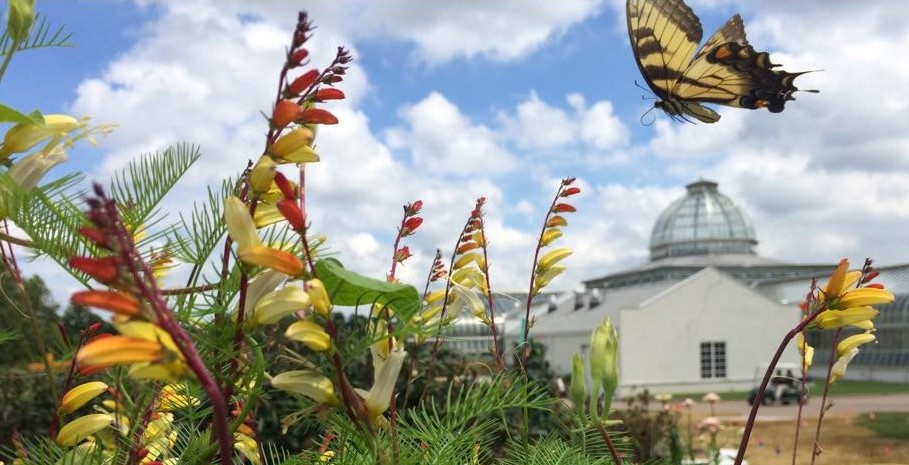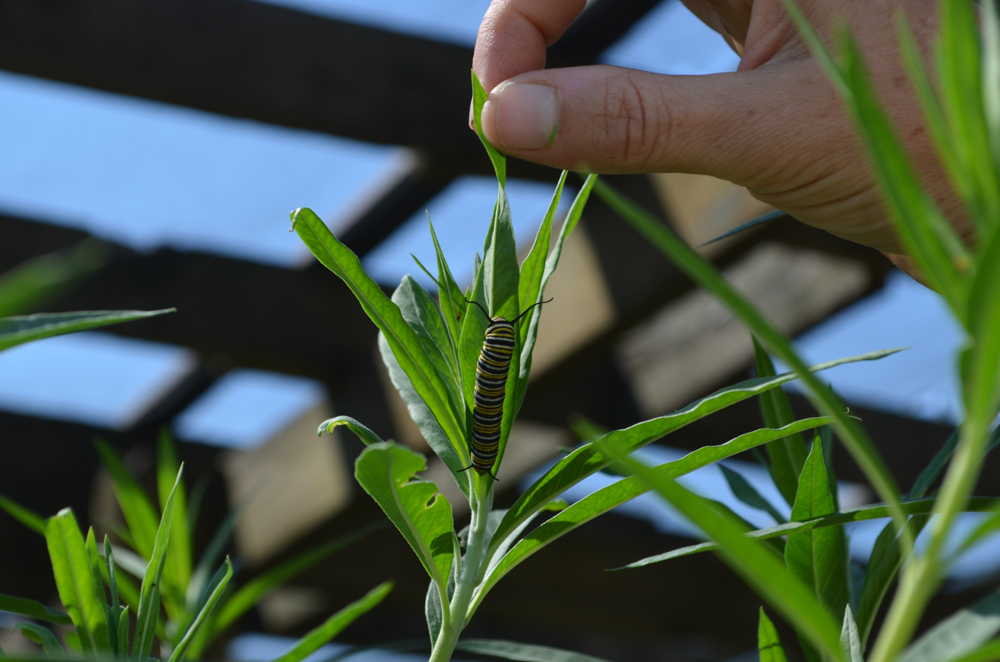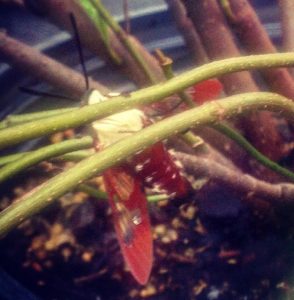The Joy of Butterfly Host Plants
Have you ever wondered which plants are butterfly host plants? Since it is officially summer, I recently packed up the car for a camping trip with friends to Crabtree Falls to see if I could learn more. The first thing I noticed when we arrived in the George Washington National Forest area was that there were a spectacular number of butterflies, and all different kinds too!
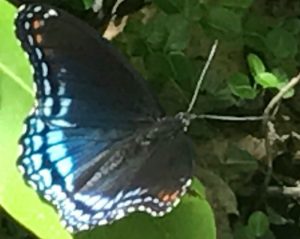
This red-spotted purple butterfly literally sparkled in the sunlight! It uses the willow (Salix spp.) as its host plant.
At the foot of the very first trail, we saw multiple summer brood spring azures butterflies. They were dancing like violet sprites in the wayside field of the state’s fish hatchery, and it reminded me of when I was a kid and seeing azure butterflies was common. Later on my trip, my eyes could hardly believe the iridescence of the red-spotted purple and my mind puzzled to identify the countless skippers. Even back at our campsite, eastern tiger swallowtails were a light and ever-present flutter over the Tye River nearby. This is why I go camping. To reconnect and wonder with the rest of the natural world.
The reason we saw so many amazing butterflies up in the mountains is because there is so much preserved plant life. Butterfly populations are fantastic bio-indicators for the health of an ecosystem and the biodiversity present. Even if you are a butterfly-lover, you may not know that most butterfly species have a very specific and limited selection of acceptable host plants. A host plant is a plant species that a caterpillar must feed upon in order to grow and become a butterfly.
Monarchs Need Milkweed
Probably the best-known example of this specific host plant relationship is the monarch and milkweed (Asclepias). Milkweed is the only acceptable host plant for the monarch larvae, so no milkweed plant means no monarch butterfly. Good thing there are lots of milkweed varieties that are native to the East Coast, and much of the United States. But in order for the monarchs to make a comeback we may have to have more “wild” areas and allow milkweed its natural place in our environment.
The quantity and volume of acceptable host plants in a given habitat directly relates to the number of native butterflies that you’ll find in that same area. This is why it is so important to plant native plants! Not only are they perfectly adapted to our local weather patterns and soil profiles, but they have evolved to provide for our native wildlife. They tend to withstand our natural weather cycles better, and require less maintenance and resources overall. It goes along to say that some non-native plants can have value as host plants for both food and nectar in your garden, but the natives have the advantage of better survival and possible a wider draw to native wild life.
Knowing that host plants are what support the local butterfly gives us a new and broader lens by which to perceive our landscapes. We begin to not just see the plant, or see the butterfly, but we begin to see the relationship between the two. Further extending this relational lens, if we see a manifold of host plants and butterfly diversity, then its safe to assume that the landscape is a vibrant cornucopia of other life forms, too, such as insects, birds, reptiles and small mammals.
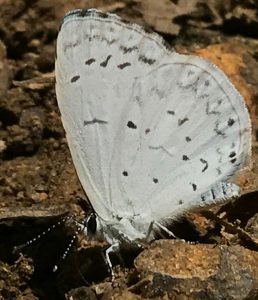
The spring azure utilizes several common ornamental shrubs and trees; such as dogwood, sumac, and viburnum as host plants — just be sure to select the native species.
Hopefully you’re fired up to add some larval host plants to your yard or garden. Remember, these plants are going to be chewed on by tiny butterfly caterpillars, so they may look a little ragged from time to time. If that bothers you, you may wish to plant them in a less prominent spot of your garden. Usually a corner pocket or naturalized section of your property will work best. It is also important to keep this garden area organic — you’d never want to spray insecticides or herbicides nearby. After selecting the space, watch it to see the amount of sun and shade you can expect (and remember, winter sun/shade ratios will differ). What is the soil profile? How is the drainage? By taking stock of what you’re working with its easy to figure out the native plants best suited for your space. Whether the space is large or small, every host plant helps our native butterfly and moth populations. Remember it’s also a good idea to plant plenty of nectar plants as well so the butterflies have plenty of blooms around after their transformation from caterpillars. Learn more about the best nectar plants and host plants and how to attract native butterflies.
Butterfly Host Plants
Here’s a list of our recommended butterfly host plants for the Mid-Atlantic; adapted from Linda McBride, Virginia Master Gardener, Virginia Master Naturalist and a true butterfly steward.
Shrubs and Trees — Butterfly Host Plants
Sassafras (Sassafras albidum) Host to spicebush swallowtails and several moth species.
Paw paw (Asimina triloba) Host to zebra swallowtails.
Wild cherry (Prunus serotina) Host to red-Spotted purples, tiger swallowtails, and several moth species.
Tulip poplar (Liriodendron tulipifera) Host to red-spotted purples, tiger swallowtails, viceroys, and several moth species.
Dogwood (Cornus florida) Host to spring azures and cecropia moths.
Oak (Quercus spp.) Host to both butterflies and moths too numerous to mention.
Spicebush (Lindera benzoin) Host to spicebush swallowtails.
Blueberry (Vaccinium spp.) Host to spring azures, brown elfins, striped hairstreaks, and several moth species.
Viburnum (Viburnum spp.) Host to spring azures and hummingbird clearwing moths. Includes Southern arrow-wood (V. dentatum), possumhaw (V. nudum), and black-haw (V. prunifolium).
Annuals, Biennials, and Perennials — Butterfly Host Plants
Milkweeds (Asclepias) Host to monarchs and milkweed tussock moths. Also excellent nectar plants. Includes common milkweek (A. syriaca), swamp milkweed (A. incarnata), butterfly weed (A. tuberosa) and tropical milkweed (A. curassavica). All but tropical milkweed (also called bloodflower) are perennial.
Violets (Viola spp.) Host to fritillaries.
Aster (Aster spp.) Host to pearl crescents, silvery checkerspots, American ladies. Also excellent fall nectar plants.
Cassia or wild senna (Cassia hebecarpa) Host to sleepy oranges, cloudless sulphurs, little yellows.
Some non-native plants can have value as host plants for both food and nectar in your garden but the natives have the advantage of better survival and possible a wider draw to native wild life. Plants in this category include Queen Anne’s lace (Daucus carota), as well as parsley, fennel, and dill, which are host plants to black swallowtails (but are not native).
Vines
American wisteria (Wisteria frutescens) Host to silver-spotted skipper and long-tailed skipper. This wisteria is our native wisteria, not the invasive non-native.
Pipevine or dutchman’s pipe (Aristolochia macrophylla) Host to pipevine swallowtails.
Passionflower (Passiflora incarnata) Host to variegated fritillaries.
While this list is not comprehensive it is a great place to start. Do you have any stories about planting your own butterfly larva host plant you’d like to share? Which butterfly host plants have you had the best luck with?
